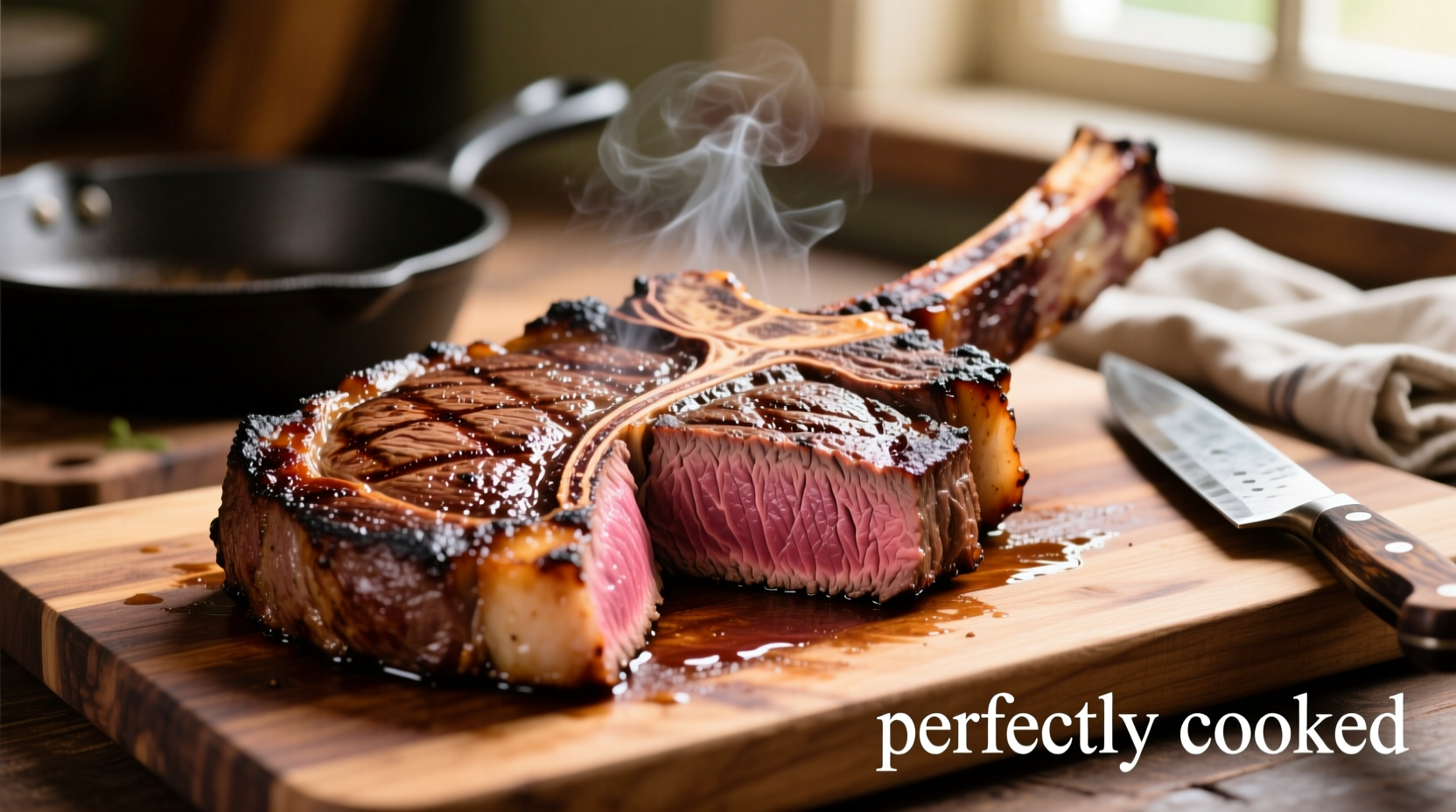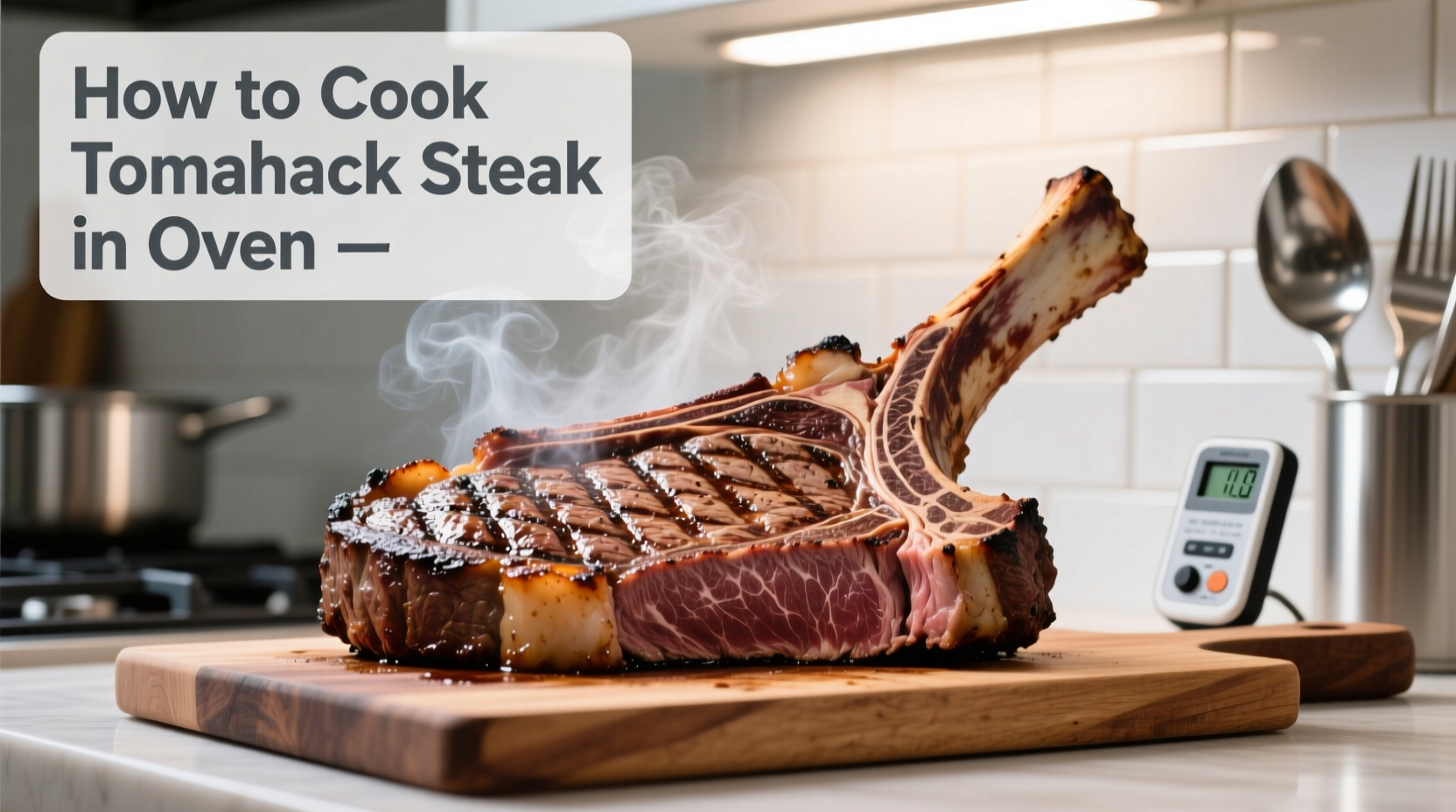The perfect oven-cooked tomahawk steak requires a reverse sear method: preheat oven to 275°F (135°C), season generously, roast until internal temperature reaches 120-125°F (49-52°C) for medium-rare, then finish with a 2-3 minute high-heat sear. Total cooking time ranges from 45-75 minutes depending on steak thickness, followed by a critical 15-minute rest period before serving.
Mastering the tomahawk steak in your oven transforms a potentially intimidating cut into a show-stopping meal. This bone-in ribeye, typically 2-3 inches thick and weighing 32-45 ounces, demands special attention due to its unique structure. Unlike standard steaks, the tomahawk's substantial thickness and bone require precise temperature control to achieve even cooking without drying out the meat. Professional chefs consistently recommend the reverse sear technique for optimal results—starting low and slow in the oven before finishing with a high-heat sear. This method guarantees a perfectly pink interior from edge to edge with a crisp, flavorful crust.
Why the Oven Method Works Best for Tomahawk Steak
The tomahawk's impressive size presents unique challenges. The bone conducts heat differently than the meat, while the extreme thickness makes conventional searing methods risky—you'd likely burn the exterior before the center reaches proper temperature. The USDA Food Safety and Inspection Service confirms that steak should reach a minimum internal temperature of 145°F (63°C) with a 3-minute rest for food safety, though many prefer lower temperatures for medium-rare. The oven's gentle, even heat solves this problem by allowing the entire cut to approach target temperature gradually before the final sear.
Your Tomahawk Steak Preparation Checklist
Success begins long before the steak hits the oven. Proper preparation prevents common pitfalls that ruin even expensive cuts.
Equipment Essentials
You'll need these non-negotiable items:
- Heavy-duty oven-safe skillet or roasting pan (cast iron preferred)
- Digital meat thermometer (critical for precision)
- Wire cooling rack
- Aluminum foil
- Heavy kitchen towel
Selecting & Preparing Your Steak
Choose a USDA Prime graded tomahawk with even marbling throughout—avoid steaks with large gaps in fat distribution. Remove the steak from refrigeration 1-2 hours before cooking to bring it to room temperature. This crucial step prevents uneven cooking. Pat the surface completely dry with paper towels; moisture is the enemy of proper searing. Trim any excessive fat caps exceeding 1/4 inch thickness to prevent flare-ups during searing.
| Doneness Level | Target Oven Temp | Final Internal Temp | Resting Temp Rise |
|---|---|---|---|
| Medium-Rare | 120-125°F (49-52°C) | 130-135°F (54-57°C) | +5-10°F (+3-6°C) |
| Medium | 125-130°F (52-54°C) | 140-145°F (60-63°C) | +5-10°F (+3-6°C) |
| Medium-Well | 130-135°F (54-57°C) | 150-155°F (66-68°C) | +5-10°F (+3-6°C) |
The Reverse Sear Method: Step-by-Step
Step 1: Oven Setup & Seasoning
Preheat your oven to 275°F (135°C)—this low temperature allows gradual, even heating. While the oven heats, season the steak generously with coarse kosher salt and freshly ground black pepper on all surfaces, including the edges. For enhanced flavor, add crushed garlic powder and smoked paprika. Professional chefs at the Culinary Institute of America recommend seasoning at least 45 minutes before cooking to allow salt penetration.
Step 2: Low-Temperature Roasting
Place the steak on a wire rack set inside a roasting pan. Insert your meat thermometer into the thickest part of the meat, avoiding the bone. Roast until the internal temperature reaches 10-15°F below your desired final temperature (refer to the chart above). This typically takes 45-75 minutes depending on steak thickness. Resist the urge to check frequently—each oven opening adds significant cooking time.

Step 3: The Critical Sear
While the steak roasts, heat your cast iron skillet over high heat until smoking hot (about 5 minutes). Add 1 tablespoon of high-smoke point oil (avocado or grapeseed). Once the steak reaches target oven temperature, transfer it directly to the hot skillet. Sear for 90-120 seconds per side, including the edges, until a deep brown crust forms. Baste continuously with melted butter, fresh thyme, and crushed garlic for professional results.
Step 4: The Non-Negotiable Rest
Transfer the steak to a cutting board and tent loosely with foil. Rest for at least 15 minutes—this allows juices to redistribute throughout the meat. Cutting too soon releases precious juices onto the board rather than staying in the steak. The internal temperature will continue rising 5-10°F during this period (carryover cooking).
Avoiding Common Tomahawk Steak Mistakes
Even experienced cooks make these critical errors:
- Skipping the dry surface step—moisture prevents proper searing
- Using an inaccurate thermometer—calibrate yours before cooking
- Overcrowding the pan—causes steaming instead of searing
- Cutting too soon—lose up to 30% of juices when skipping rest time
- Guessing doneness—always use a thermometer for precision
Serving Your Masterpiece
Slice against the grain in 1/2-inch thick portions, cutting away from the bone. For dramatic presentation, leave one portion attached to the bone as a "handle." Pair with simple sides that complement without overwhelming—the steak should be the star. Classic accompaniments include roasted garlic mashed potatoes and sautéed asparagus. A full-bodied red wine like Cabernet Sauvignon completes the experience.
Tomahawk Steak Cooking FAQ
These frequently asked questions address the most common concerns when preparing this impressive cut:
Can I cook tomahawk steak in oven without searing?
Yes, but you'll miss the essential Maillard reaction that creates complex flavors. Without searing, the exterior lacks the rich, caramelized crust that defines a properly cooked steak. The reverse sear method combines oven roasting with final searing for optimal texture and flavor development.
How long to cook tomahawk steak at 350 degrees?
At 350°F, a tomahawk steak typically requires 30-45 minutes to reach medium-rare, but this method risks uneven cooking. The recommended approach uses 275°F for the initial roast (45-75 minutes) followed by a high-heat sear. Higher oven temperatures increase the risk of overcooking the outer layers before the center reaches proper temperature.
Why does my tomahawk steak come out tough?
Toughness usually results from insufficient resting time or overcooking. The tomahawk's thickness requires proper carryover cooking during the 15-minute rest period. Cooking beyond 145°F internal temperature causes excessive protein contraction, squeezing out moisture. Always use a thermometer and allow full resting time for tender results.
Should I salt tomahawk steak before cooking?
Yes, salt at least 45 minutes before cooking. This allows time for the salt to penetrate the meat surface, enhancing flavor and improving texture through protein breakdown. For best results, use coarse kosher salt which adheres better and distributes more evenly than fine table salt.
How do I know when tomahawk steak is done?
The only reliable method is using an instant-read digital thermometer. For medium-rare, remove from oven when internal temperature reaches 120-125°F (49-52°C), then finish with searing. The final temperature after resting should be 130-135°F (54-57°C). Visual cues like firmness are unreliable with thick cuts like tomahawk steaks.











 浙公网安备
33010002000092号
浙公网安备
33010002000092号 浙B2-20120091-4
浙B2-20120091-4